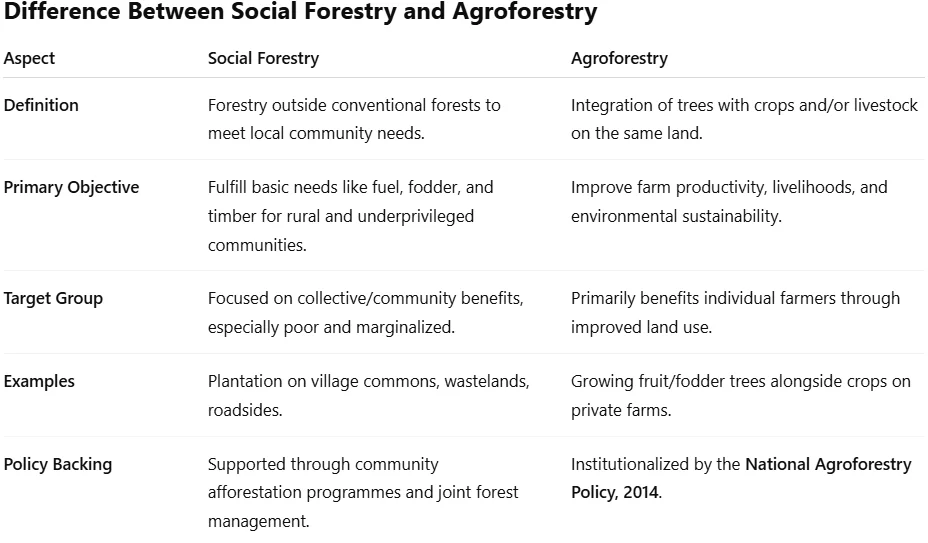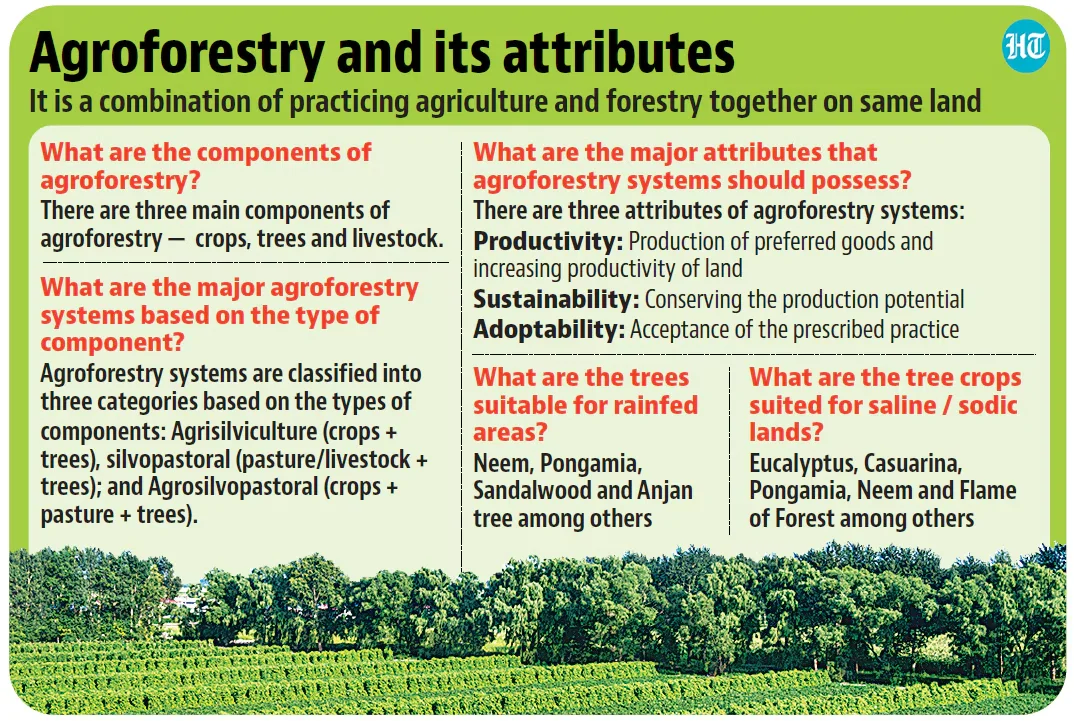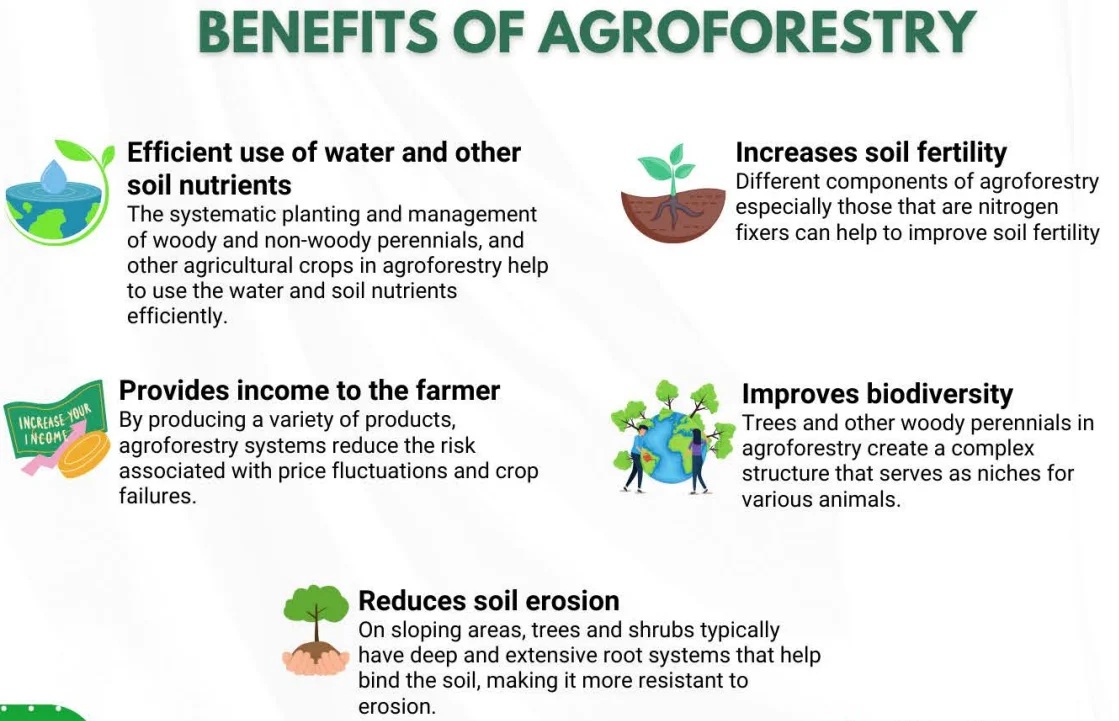Rules for Promotion of Agroforestry | 04 Jul 2025
For Prelims: Agroforestry, Climate Change, Carbon Sequestration, Land Degradation Neutrality by 2030, Sustainable Farming, Sub-Mission On Agroforestry (SMAF), National Agroforestry Policy (NAP)
For Mains: Agroforestry- Model Rules, Significance and Challenges
Why in News?
The Ministry of Environment, Forest and Climate Change (MoEFCC) has issued Model Rules for Felling of Trees on Agricultural Lands to streamline permissions, promote agroforestry, boost rural incomes, and reduce pressure on natural forests.
- The rules mandate a digital portal with remote sensing and image recognition for transparency and monitoring. This aligns with India’s commitments under UNFCCC, CBD, and supports SDGs 2, 13, and 15.
What are the Key Highlights of Model Rules by MoEFCC for Promoting Agroforestry?
- Simplified Regulations: Uniform procedures for tree registration, felling, and timber transit on agricultural lands; overrides conflicting state rules for legal clarity.
- NTMS Portal: Centralized National Timber Management System (NTMS) enables farmers to register plantations, apply for felling permits, and track applications using geo-tagged data, KML files, and photos.
- Tree-Based Categorization: Felling of more than 10 trees requires physical verification by empanelled agencies, while 10 or fewer trees can be self-declared by farmers on the NTMS portal for an automated NOC.
- Institutional Mechanism:
- State Level Committee (SLC) under 2016 Wood-Based Industries Guidelines to promote agroforestry.
- Divisional Forest Officers (DFOs) to supervise empanelled agencies for compliance.
- Technology-Driven Monitoring: Use of remote sensing, image recognition, and digital tools for real-time monitoring and transparency.
- Market Linkages: Encourages use of locally sourced timber, reducing imports. Promotes cultivation of high-value species (e.g., teak, eucalyptus, poplar) to boost farmer income.
What is Agroforestry?
- About: Agroforestry (agriculture with trees), is a land-use system where trees are grown together with crops and/or livestock on the same land to improve farm productivity, livelihoods, and environmental sustainability.
- By combining trees with agriculture, it ensures better use of land and supports rural livelihoods in an eco-friendly way.
- Agroforestry was formally promoted in India through the National Agroforestry Policy, 2014.
- In India, agroforestry covers 28.4 million hectares, which is 8.65% of the country’s total land area.
- Components:
- Trees on farms and in agricultural landscapes, providing fodder, fuel, timber, fruits, or income.
- Tree-crop combinations like cocoa, coffee, oil palm, and rubber.
- Farming in or near forests, helping manage land near forest edges sustainably.
- Types of Agroforestry:
- Farm Forestry: Tree cultivation by farmers on their own land, often for commercial purposes.
- Promoted by National Commission on Agriculture (NCA) (1976) to integrate forestry with farm operations.
- Extension Forestry: Raising trees in non-forested, degraded areas to expand green cover.
- Mixed Forestry: Combines fuelwood, fodder, and fruit trees on wastelands or village commons.
- Shelterbelts: Rows of trees/shrubs to protect against wind, sun, and soil erosion.
- Linear Strip Plantations: Fast-growing trees planted along roads, canals, and railway lines.
- Farm Forestry: Tree cultivation by farmers on their own land, often for commercial purposes.
What are the Key Benefits of Agroforestry?
- Economic Contribution: Agroforestry meets nearly half of India’s fuelwood needs, two-thirds of small timber demand, 60% of raw material for paper pulp, and around 9–11% of green fodder demand.
- It supports rural livelihoods through diverse products like fruit, fodder, fuel, fibre, fertiliser, and timber, enhancing income, food security, and resilience to crop failure.
- Environmental Benefits:
- Carbon Sequestration & Climate Mitigation: Agroforestry, with adequate support, can sequester over 2.5 billion tonnes of CO₂-equivalent by 2030. Integrated Afforestation, Reforestation, and Revegetation (ARR) projects further enhance its role as a carbon sink, supporting land restoration and climate resilience, contributing to India’s net-zero target by 2070.
- Improved Soil Fertility: Nitrogen fixing trees grown in the agro forestry systems are capable of fixing about 50 -100 Kg N/ha/year. Leaf litter decomposition forms humus, recycles nutrients, and improves soil health, reducing the need for chemical fertilisers and supporting organic farming.
- Ecological Sustainability: Agroforestry improves soil health, water retention, nutrient cycling, and biodiversity, reducing dependency on agrochemicals.
- It also aids in integrated pest management by hosting diverse species that naturally regulate pests, while enhancing climate resilience through ecological stability.
- Support for Global Commitments: Agroforestry contributes to India’s international targets like creating an additional carbon sink of 2.5–3 billion tonnes of CO₂-equivalent by 2030 and achieving Land Degradation Neutrality over 26 million hectares.
- It also aligns with 9 out of 17 Sustainable Development Goals (SDGs).
- Renewable Energy Promotion: Agroforestry supports the generation of sustainable biomass-based energy, contributing to clean and renewable energy goals.
What are the Key Government Initiatives on Agroforestry?
- National Agroforestry Policy (NAP), 2014: India became the first country to adopt a dedicated agroforestry policy, promoting integrated agriculture–forestry systems on private and community lands.
- It called for ministerial convergence, simplified felling and transit rules, institutional support (e.g., CAFRI), and research–extension linkages.
- The policy laid the foundation for the Sub-Mission on Agroforestry (SMAF) and inspired similar policies in ASEAN, Rwanda, Nepal, and Ethiopia.
- Sub-Mission on Agroforestry (SMAF), 2016: Launched under the National Mission for Sustainable Agriculture (NMSA), SMAF aims to promote tree plantation on farmlands, especially for small and marginal farmers, by providing incentives for seedling procurement, plantation, protection, and extension.
- All India Coordinated Research Project (AICRP), 1983: Initiated by ICAR, AICRP is a national research network focused on developing and improving agroforestry systems suited to India’s diverse agro-climatic zones.
- GROW: Launched by NITI Aayog, GROW (Greening and Restoration of Wasteland with Agroforestry) aims to restore 26 million hectares of degraded land by 2030 and contribute to India's carbon sink target of 2.5–3 billion tonnes CO₂-equivalent under the Paris Agreement.
- It uses Remote Sensing, GIS, and the Agroforestry Suitability Index (ASI) on the Bhuvan Portal to guide interventions at national, state, and district levels.
What are the Key Challenges in Effective Utilization of Agroforestry Policy?
- Regulatory & Institutional Fragmentation: Varying tree felling and transit rules across States, poor coordination among forestry, agriculture, and rural development departments hinder uniform implementation.
- Low Awareness and Technical Capacity: Farmers lack awareness of policy benefits, ecological value, and best practices.
- Shortage of trained extension staff and limited access to scientific knowledge on species selection, plantation techniques, and integrated pest management restrict adoption.
- Financial and Market Constraints: High initial investment, long gestation period, lack of insurance and agroforestry-specific credit schemes make it financially risky.
- Weak linkages with wood-based industries and absence of price assurance reduce profitability.
- Digital and Monitoring Gaps: Low digital literacy and poor connectivity limit use of the National Timber Management System (NTMS).
- Inadequate real-time monitoring affects traceability, transparency, and compliance, especially for smallholders.
- Research and Perception Barriers: Lack of region-specific R&D on tree-crop models and climate-resilient species, along with farmer risk aversion, uncertainty in returns affects confidence and large-scale adoption.
What Measures Should be Taken for Effective Implementation of Agroforestry Policy?
- Regulatory Reforms: Develop a uniform national framework for tree felling and transit rules, while strengthening coordination through fully functional State Level Committees (SLCs) to ensure consistent implementation across States.
- Awareness and Capacity Building: Launch localized awareness and training programs through KVKs, ICAR, and forest departments to educate farmers and extension workers on policy benefits, climate-resilient models, and integrated pest management.
- Financial and Market Support: Introduce agroforestry-specific credit and insurance schemes, promote public-private partnerships, and establish buy-back arrangements with wood-based industries to improve profitability and reduce financial risk.
- Digital Access and Monitoring: Expand rural digital infrastructure to enhance use of the NTMS portal, and integrate GIS, remote sensing, and AI-based tools for real-time monitoring, traceability, and compliance.
- Research and Demonstration: Invest in region-specific R&D on productive, climate-smart species and establish model agroforestry farms to showcase best practices, reduce risk perception, and build farmer confidence.
Conclusion
The Model Rules offer a transformative approach to mainstream agroforestry as a tool for climate-resilient agriculture, rural income generation, and natural resource conservation. Addressing implementation challenges through institutional coordination, digital empowerment, and market development will be crucial to realizing their full potential in India's agricultural and environmental landscape.
|
Drishti Mains Question: Agroforestry has the potential to address India’s timber needs, improve rural incomes, and promote ecological balance. Analyse the challenges in its implementation and suggest a viable roadmap. |
UPSC Civil Services Examination, Previous Year Question (PYQ)
Prelims:
Q. In the context of India’s preparation for Climate -Smart Agriculture, consider the following statements: (2021)
- The ‘Climate-Smart Village’ approach in India is a part of a project led by the Climate Change, Agriculture and Food Security (CCAFS), an international research programme.
- The project of CCAFS is carried out under Consultative Group on International Agricultural Research (CGIAR) headquartered in France.
- The International Crops Research Institute for the Semi-Arid Tropics (ICRISAT) in India is one of the CGIAR’s research centres.
Which of the statements given above are correct?
(a) 1 and 2 only
(b) 2 and 3 only
(c) 1 and 3 only
(d) 1, 2 and 3
Ans: (d)
Q. Consider the following pairs: (2014)
Programme/Project Ministry
- Drought-Prone Area Programme - Ministry of Agriculture
- Desert Development Programme - Ministry of Environment and Forests
- National Watershed Development Project for Rainfed Areas - Ministry of Rural Development
Which of the above pairs is/are correctly matched?
(a) 1 and 2 only
(b) 3 only
(c) 1, 2 and 3
(d) None
Ans: (d)
Q. In India, which of the following can be considered as public investment in agriculture? (2020)
- Fixing Minimum Support Price for agricultural produce of all crops
- Computerization of Primary Agricultural Credit Societies
- Social Capital development
- Free electricity supply to farmers
- Waiver of agricultural loans by the banking system
- Setting up of cold storage facilities by the governments
Select the correct answer using the code given below:
(a) 1, 2 and 5 only
(b) 1, 3, 4 and 5 only
(c) 2, 3 and 6 only
(d) 1, 2, 3, 4, 5 and 6
Ans: (c)
Mains
Q. Given the vulnerability of Indian agriculture to vagaries of nature, discuss the need for crop insurance and bring out the salient features of the Pradhan Mantri Fasal Bima Yojana (PMFBY). (2016)
Q. Explain various types of revolutions, took place in Agriculture after Independence in India. How have these revolutions helped in poverty alleviation and food security in India? (2017)



